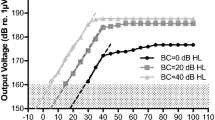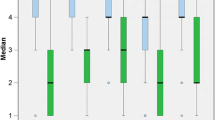Abstract
Background
The objective-based methods for intraoperative monitoring have been suggested to assess the coupling and the outcomes of Vibrant Soundbridge (VSB). Although several techniques were proposed, they have not been widely adopted due to their complexity and invasiveness.
Purpose
This study aimed to investigate the accuracy of a new coupling quality index using an intraoperative ABR threshold via AcoustiAP and its correlation with the perioperative measures.
Methods
This is a prospective study conducted at a tertiary center. The medical records were retrieved for all patients who underwent VSB implantation and had an intraoperative objective assessment for the coupling efficiency. AcoustiAP was used to evaluate the intraoperative ABR thresholds, which were assessed directly after the floating mass transducer (FMT) placement using acoustic CE-Chirp signals. The Vibrogram was used for the postoperative audiological evaluation. A new coupling quality index was calculated based on the intraoperative ABR thresholds.
Results
Ten patients were eligible for the present study. The ABR thresholds for good coupling ranged from 35 to 60 dBnHL. The loose coupling thresholds ranged considerably from 40 to 100 dBnHL. Overall, the median intraoperative ABR threshold at good coupling was 42.5 (40–60) dBnHL and 60 (40–100) dBnHL at loose coupling. The analysis showed that there was a significant change in the coupling quality index at the good and loose coupling points (24.3 ± 14 vs 38.8 ± 18.2, respectively, p < 0.001). At a cut-off value of 22.6 dB, the coupling quality index had a sensitivity of 70% and specificity of 90% for discriminating good and loose coupling.
Conclusion
This study provides evidence for the utility of intraoperative ABR measurements in predicting the coupling efficiency in patients with VSB. Our results showed that the coupling quality index had an acceptable accuracy in discriminating between good and poor coupling, which can help clinicians optimize the fitting process for individuals and may ultimately lead to improved patient outcomes.






Similar content being viewed by others
Data availability
The datasets used and analyzed during the current study are available from the corresponding author upon reasonable request.
References
Colletti V, Soli SD, Carner M, Colletti L (2006) Treatment of mixed hearing losses via implantation of a vibratory transducer on the round window. Int J Audiol 45(10):600–608
Sprinzl GM, Riechelmann H (2010) Current trends in treating hearing loss in elderly people: a review of the technology and treatment options—a mini-review. Gerontology 56(3):351–358
Al-shawi Y, Alsughayer L, Alradhi A, Alzhrani F (2021) middle ear implant in a patient with fibrous dysplasia: an alternative for hearing restoration. Ear Nose Throat J 100(3_suppl):207S-211S
Alzhrani F, Halawani R, Yousef M (2020) Feasibility and efficacy of Vibrant Soundbridge short process coupler in patients with aural atresia. Otol Neurotol 41(10):e1219–e1223
Alanazi Y, Halawani R, Alzhrani F (2020) Vibrant soundbridge implant in a patient with Fanconi anemia. Acta Oto-Laryngologica Case Rep 5(1):42–46
Zwartenkot JW, Hashemi J, Cremers CWRJ, Mulder JJS, Snik AFM (2013) Active middle ear implantation for patients with sensorineural hearing loss and external otitis: long-term outcome in patient satisfaction. Otol Neurotol Off Publ Am Otol Soc Am Neurotol Soc [and] Eur Acad Otol Neurotol 34(5):855–861
Bittencourt AG, Burke PR, Jardim IDS, De BR, Tsuji RK, Fonseca ACDO et al (2014) Implantable and semi-implantable hearing aids: a review of history, indications, and surgery. Int Arch Otorhinolaryngol 18:303–310
Dillon MT, Buss E, Adunka OF, Buchman CA, Pillsbury HC (2015) Influence of test condition on speech perception with electric-acoustic stimulation. Am J Audiol 24(4):520–528
Lenarz T, Zwartenkot JW, Stieger C, Schwab B, Mylanus EAM, Caversaccio M et al (2013) Multicenter study with a direct acoustic cochlear implant. Otol Neurotol Off Publ Am Otol Soc Am Neurotol Soc [and] Eur Acad Otol Neurotol 34(7):1215–1225
Starr A, Picton TW, Sininger Y, Hood LJ, Berlin CI (1996) Auditory neuropathy. Brain 119(Pt 3):741–753
Skarzynski H, Olszewski L, Skarzynski PH, Lorens A, Piotrowska A, Porowski M et al (2014) Direct round window stimulation with the Med-El Vibrant Soundbridge: 5 years of experience using a technique without interposed fascia. Eur Arch oto-rhino-laryngology Off J Eur Fed Oto-Rhino-Laryngological Soc Affil with Ger Soc Oto-Rhino-Laryngology Head Neck Surg 271(3):477–482
Coordes A, Jahreiss L, Schönfeld U, Lenarz M (2017) Active middle ear implant coupled bilaterally to the round window despite bilateral implanted stapes prostheses. Laryngoscope 127:500–503
Ren Y, Merna CM, Tawfik KO, Schwartz MS, Friedman RA (2022) Auditory brain stem response predictors of hearing outcomes after middle fossa resection of vestibular schwannomas. J Neurol Surg B Skull Base 83(5):496–504
Feng T, Chen Y, Xiong H, Zheng Y, Yang H (2019) Application of intraoperative ABR during middle ear surgery to predict improvement in hearing. Interdiscipl Neurosurg 17:96–100
Mario C, Herrmann DP, Rudolf H, Kristen R (2022) Intraoperative auditory brainstem response measurements via the Vibrant Soundbridge active middle ear implant: comparison of two methods. Am J Audiol 31(2):261–267
Sprinzl GM, Schörg P, Edlinger S, Ploder M, Magele A (2022) Clinical feasibility of a novel test setup for objective measurements using the VIBRANT SOUNDBRIDGE. Laryngoscope Investig Otolaryngol 7(4):1113–1119
Fröhlich L, Rahne T, Plontke SK, Oberhoffner T, Dahl R, Mlynski R et al (2021) Intraoperative quantification of floating mass transducer coupling quality in active middle ear implants: a multicenter study. Eur Arch Oto-Rhino-Laryngol 278(7):2277
McCreery RW, Kaminski J, Beauchaine K, Lenzen N, Simms K, Gorga MP (2015) The impact of degree of hearing loss on auditory brainstem response predictions of behavioral thresholds. Ear Hear 36(3):309
Geiger U, Radeloff A, Hagen R, Cebulla M (2019) Intraoperative estimation of the coupling efficiency and clinical outcomes of the Vibrant Soundbridge active middle ear implant using auditory brainstem response measurements. Am J Audiol 28(3):553–559
Dejaco D, Riedl D, Gottfried TM, Santer M, Runge A, Seebacher J et al (2023) The influence of intraoperative auditory brainstem responses on vibroplasty coupling-quality and analysis of the impact of different fixation steps on the coupling. Eur Arch Oto-Rhino-Laryngol. https://doi.org/10.1007/s00405-023-08103-9
Lüers J-C, Hüttenbrink K-B (2014) Vibrant Soundbridge rehabilitation of conductive and mixed hearing loss. Otolaryngol Clin North Am 47(6):915–926
Ernst A, Todt I, Wagner J (2016) Safety and effectiveness of the Vibrant Soundbridge in treating conductive and mixed hearing loss: a systematic review. Laryngoscope 126(6):1451–1457
Koyama H, Mori A, Nagatomi D, Fujita T, Saito K, Osaki Y et al (2021) Machine learning technique reveals prognostic factors of Vibrant Soundbridge for conductive or mixed hearing loss patients. Otol Neurotol 42(9):e1286–e1292
Cebulla M, Geiger U, Hagen R, Radeloff A (2017) Device optimised chirp stimulus for ABR measurements with an active middle ear implant. Int J Audiol 56(8):607–611
Elberling C, Kristensen S, Don M (2012) Auditory brainstem responses to chirps delivered by different insert earphones. J Acoust Soc Am 131:2091–2100
Cebulla M, Hagen R, Rak K, Geiger U (2020) Intraoperative determination of coupling efficiency of Carina(®) middle ear implant by means of auditory evoked potentials. Int J Audiol 59(12):962–967
Zhou G, Dornan B, Hinchion W (2012) Clinical experience of auditory brainstem response testing on pediatric patients in the operating room. Int J Otolaryngol 2012:350437
Firszt JB, Chambers RD, Kraus N, Reeder RM (2002) Neurophysiology of cochlear implant users I: effects of stimulus current level and electrode site on the electrical ABR, MLR, and N1–P2 response. Ear Hear 23(6):502–515
Funding
No funding.
Author information
Authors and Affiliations
Corresponding author
Ethics declarations
Conflict of interest
The authors have no conflicts of interest, and the work was not supported or funded by any organization.
Ethical approval
The study was conducted in accordance with the Declaration of Helsinki and approved by the local institutional review board (No. E-22-7331).
Informed consent
The informed consent was collected from the patients pre-operatively.
Additional information
Publisher's Note
Springer Nature remains neutral with regard to jurisdictional claims in published maps and institutional affiliations.
Supplementary Information
Below is the link to the electronic supplementary material.
Rights and permissions
Springer Nature or its licensor (e.g. a society or other partner) holds exclusive rights to this article under a publishing agreement with the author(s) or other rightsholder(s); author self-archiving of the accepted manuscript version of this article is solely governed by the terms of such publishing agreement and applicable law.
About this article
Cite this article
Alahmadi, A., Yousef, M., Ibrahim, A. et al. A novel coupling quality index to estimate the coupling efficiency in Vibrant Soundbridge. Eur Arch Otorhinolaryngol 281, 2333–2340 (2024). https://doi.org/10.1007/s00405-023-08354-6
Received:
Accepted:
Published:
Issue Date:
DOI: https://doi.org/10.1007/s00405-023-08354-6




